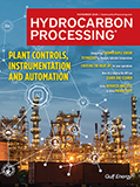Process Control
Industry Perspectives
In the second half of 2021, Hydrocarbon Processing is hosting two events to showcase the leading technologies and people in the refining, petrochemicals and gas processing/LNG industries: The International Refining and Petrochemical Conference (IRPC) and the HP Awards. A “call for abstracts” has opened for both events.
Leveraging digital technologies to create the smart renewable diesel facility
Many companies are modifying existing crude refineries or building grassroots renewable diesel facilities to produce drop-in, green renewable diesel from a variety of agriculturally derived triglyceride feedstocks.
Business Trends: A perspective on new technology impacts on the chemical processing industry
Over the past five years, the industrial evolution has been propelled by the same technologies that have dramatically changed our private lives.
Executive Viewpoint: Interconnected neural networks drive breakthrough optimization
We have all learned that technology alone will not improve our operations.
Smart manufacturing standardization: Driving global interoperability for enabling factories of the future
Smart manufacturing is a topic that has generated considerable discussions within industry and standards organizations.
Unlock margin by interconnecting refinery optimization silos with closed-loop AI
Refineries and chemical processing plants are complicated to model, control and optimize.
Improve reliability and reduce maintenance with advanced analytics
A common misconception in largescale process manufacturing is that minimizing downtime by increasing reliability is the key to increasing profitability.
Troubleshoot flooding problems in a crude distillation column
Crude oil is separated into more valuable products, such as naphtha, kerosene, light diesel, heavy diesel and atmospheric residue, in crude distillation units (CDUs).
Editorial Comment: The tools advancing the HPI into the digital age
The HPI has been going through a digital transformation, increasingly adopting digital technologies to improve existing processes and structures to improve performance.
Improving asset utilization by closing the corrosion window
Driving profitable refinery operations often requires owner-operators to balance production flexibility and product optimization with asset availability and equipment reliability.

- NAPCOR releases 2024 PET recycling report highlighting system efficiency gains and continued strength of PET circularity 12/12
- OQ courts other partners for petrochemical complex in Oman as SABIC drops out 12/12
- Brazil's BNDES approves $71 MM for carbon storage project 12/12
- Cuba on edge as U.S. seizure of oil tanker puts supply at risk 12/12
- China oil demand to plateau between 2025 and 2030 12/12
- Germany's PCK refinery says no impact from pipeline leak 12/12




